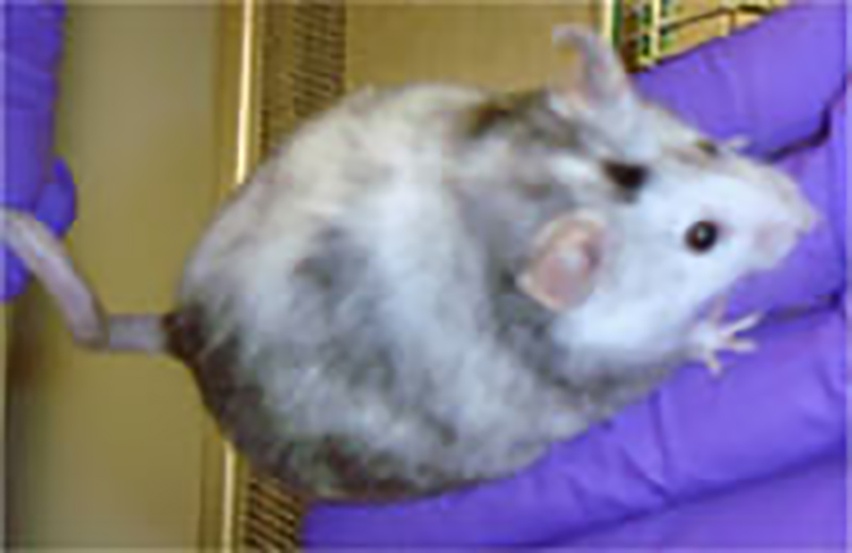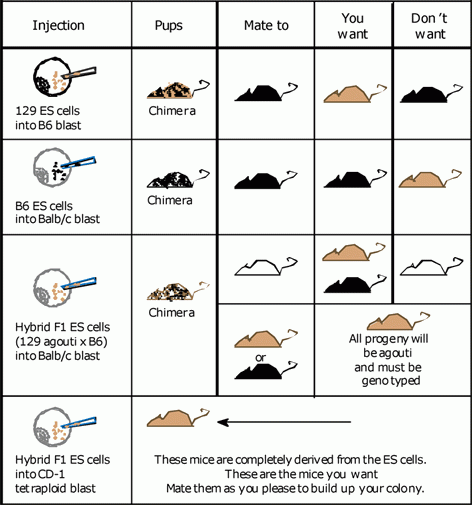Updated July 2013
Summary
There are three types of mouse embryonic stem (ES) cells that are used routinely for targeting and generation of mice at MIT: 129, C57BL/6 and 129/B6 F1. Each has unique characteristics, advantages and disadvantages, and the process of establishing a new mouse colony differs slightly depending on the type of ES cell line used.
The process of generating a targeting construct and targeting the ES cells is described in the Beginner's Guide to Mouse Targeting, the Gene Targeting Timeline, and other documents on our Methods page.
Once you have identified correctly targeted ES cells, they are injected into the blastocoel (open cavity) of 3.5 day old mouse blastocysts in the injection suite in the 68N animal facility.

Injected embryos are transferred to the uterine horns of appropriately timed pseudopregnant recipient females. Embryos gestate for 18 days and the resulting pups are chimeras, whose tissues have developed from both the ES cells and the recipient blastocyst cells. This mix of starter cells is visible in the mouse's coat, which exhibits patches of coat color from the host embryo and patches from the injected ES clone.

Coat color percentages can be determined 10 days after birth, and sex determined by 3 weeks of age. Chimeric pups are typically weaned at 3-4 weeks of age, and their dam is tested for pathogens. If the pathogen report is clean, the chimeras are transferred to your mouse room at 6-7 weeks of age for you to breed. It is recommended that mice with 50% or higher ES cell contribution be set up with a mate to test for germline transmission of the targeted allele. Occasionally, chimeras as low as 35% have given germline transmission.
The bare bones to help you pick which type of ES cell to use:
- If you do not care about strain background for your mice, I strongly recommend using the 129/B6 F1 hybrid line called V6.5. You can use C57BL/6 BAC DNA to generate your construct, the cells are highly robust, and you can generate 100% ES cell-derived mice directly (skipping chimeras) by injecting the targeted cells into tetraploid blastocysts.
- Building a construct to target C57BL/6 ES cells is fast because this genome has been sequenced and the BAC DNA is very easy to obtain. However, C57BL/6 cells are less robust than 129 ES cells and C57BL/6 mice are less fertile and more likely to eat their young. So, C57BL/6 is easier in the beginning, but can be more frustrating once you have chimeras.
- 129 ES cells are highly robust and go germline well. However, the sequence of the 129 genome is not known, and BACs are less easy to obtain. Therefore, there is more effort required up front with molecular biology, but once you get the construct made, obtaining a good chimera and building your colony is fairly easy.
Aurora's pocket guide to chimera

Detailed specifics for each type of ES cell line
129 Background
ES cell targeting was first established in 129 cells, so a majority of published targeted mice were derived from 129 ES cell lines. However, the sequence of the 129 genome has not been completed, and there can be much variation between the known C57BL/6 sequence and the 129 sequence, especially in non-coding regions. Currently, most researchers targeting 129 ES cells use the known sequence of exons to PCR their locus in manageable pieces from genomic (tail) DNA from a 129 source (not as easy as it sounds). Then you must do your own sequencing or digests of the pieces to identify where restriction sites are for cloning and Southerns, and to make sure no mutations were introduced in an exon. Some examples of 129 ES cells include J1 and R1, which have proven very reliable. Many animals were generated using the 129 ES line called D3, but this cell line became aneuploidy over time and many labs found that it had trisomy 8, which produced fast-growing, beautiful ES cells but would not contribute to the germline of chimeras.
ES cells derived from 129 mice carry genes that result in a black agouti (brown), chinchilla (dark grey) or white coat color. Most of the 129 ES cell lines used at MIT confer the agouti color. The agouti coat color in 129 ES cells is dominant to the black coat color of C57BL/6 cells. Therefore, 129 ES cells are injected into a C57BL/6 recipient blastocyst. The resulting chimera then has patches of agouti (brown) and patches of black. In addition to the fact that 129 cells are nicely robust, there are two factors that contribute to the fact that it is not unusual to get chimeras that are 90%-100% agouti. First, it seems that 129 cells may grow faster than C57B6 cells in the developing mouse embryo. Secondly, the agouti pigment is a secreted protein, so the brown coat color may spread a bit to cover areas that are actually derived from black cells. To begin your new mouse colony, take advantage of the fact that agouti is dominant to the black of C57BL/6, and mate the 129/B6 mix chimeras to C57BL/6 mice. Progeny will be either agouti (brown) when the 129 ES cells have contributed to the chimera's germline, or progeny will be black when cells from the C57BL/6 recipient blastocyst have contributed to the germline. All the agouti pups should then be genotyped to find out which ones have received the targeted allele. (in most cases, only one of the two alleles were mutated in the ES cell, so only 50% of the agouti mice will inherit a mutated allele). If it is critical to maintain your mutation on a pure 129 background, you can mate your chimeras to C57BL/6 mice first to see which chimeras are passing on the mutation, then move those successful chimeras to new cages to mate with 129 mice. Now, all progeny will be agouti in color (because the wild type 129 mate will always pass on the agouti gene) so all pups must be genotyped.
C57BL/6 Background
Generating a targeting construct to target C57BL/6 ES cells is relatively easy due to the sequencing of the C57BL/6 mouse genome and the inexpensive, easy availability of genomic DNA from the C57BL/6 mouse in the form of sequenced, overlapping BAC vectors. This is especially useful if you want your mutation/alteration on a pure C57BL/6 background. However, there are a very limited number of C57BL/6 ES cell lines (including v26.2, Bruce4 and JM8) and they are not as successful at contributing to the germline of chimeras. C57BL/6 ES have a tendancy to become aneuploid, and all cell lines used at our facility have developed a population of trisomy 8 cells, which grow faster than euploid cells and overwhelm the culture. These cells produce good chimeras, but do not go germline. Also, C57BL/6 mice tend to have smaller litters, eat their young, and exhibit diminished fertility at an earlier age as compared to 129 mice. Even with these limitations, some investigators really love using the C57BL/6 ES cells, and have published their reasoning for the recommendation:
E. Seong, et al, "To Knockout in 129 or in C57BL/J: That is the Question", TRENDS in Genetics, Vol. 20, No.2, February 2004, pp. 59-62
These ES cells will produce mice with a black coat color. To generate chimeras, targeted C57BL/6 ES cells are injected into a Balb/c recipient blastocyst (white coat color). The white Balb/c cells actually contain a masked agouti pigment, which is uncovered when it contacts the black pigment. Therefore, chimeras born from this mix of cells have patches of black and patches of white, with agouti hairs at the borders. Small patches of cells from the C57BL/6 ES cells will simply appear agouti on the white coat. To begin your new mouse colony, you can maintain your mutation on the C57BL/6 background while taking advantage of the fact that black is dominant to the white/masked agouti of Balb/c, and mate your C57BL/6-Balb/c mix chimeras to C57BL/6 mice. Progeny will be either black when the C57BL/6 ES cells have contributed to the chimera's germline, or progeny will be agouti(brown) when cells from the Balb/c recipient blastocyst have contributed to the germline. Again, Balb/c crossed to C57BL/6 will unmask the agouti gene of Balb/c, giving brown pups, which are not the pups you want this time. In this mating, all the black pups should be genotyped to find out which ones have received the targeted allele. Once again, most gene targetings only mutate one of the two alleles in the ES cell, so only 50% of the black mice will inherit a mutated allele. Mice with the targeted allele can be mated to each other or to wild type C57BL/6 mice and the background of the strain will remain pure C57BL/6.
129/B6 F1 Hybrid Background
The most common 129/B6 F1 hybrid line is V6.5 from the Jaensich Lab. These ES cells resulted from a 129 x C57BL/6 mating, so they have 50% contribution from each background. They can, therefore, be targeted with the easily-available C57BL/6 DNA, are extremely robust and contribute well to the germline of chimeras. These ES cells can be injected into C57BL/6 recipient blastocysts to generate chimeras, into Balb/c recipient blastocysts to generate chimeras, or they can also be injected into tetraploid mouse embryos to generate mice derived entirely from the ES cells. (See details below). 129/B6 F1 hybrid ES cells produce mice with an agouti coat, so hybrid ES cells injected into a C57BL/6 blastocyst will produce chimeras that are agouti and black, appearing the same as chimeras generated when 129 ES cells are injected into C57BL/6 blastocysts. Mating the chimeras resulting from 129/B6 F1 hybrid ES cells is less straight-forward, however. Recall that the ES cells are 50% 129 and 50% C57BL/6, so 50% of the sperm which has developed from these cells will produce the agouti pigment, but the other 50% of ES cell-derived sperm will only produce black pigment. Therefore, Hybrid/B6 chimeras should be mated to C57BL/6 mice and you watch for litters that have even one agouti mouse. The presence of any agouti progeny signifies that the ES cells contributed to the germline of the chimera.